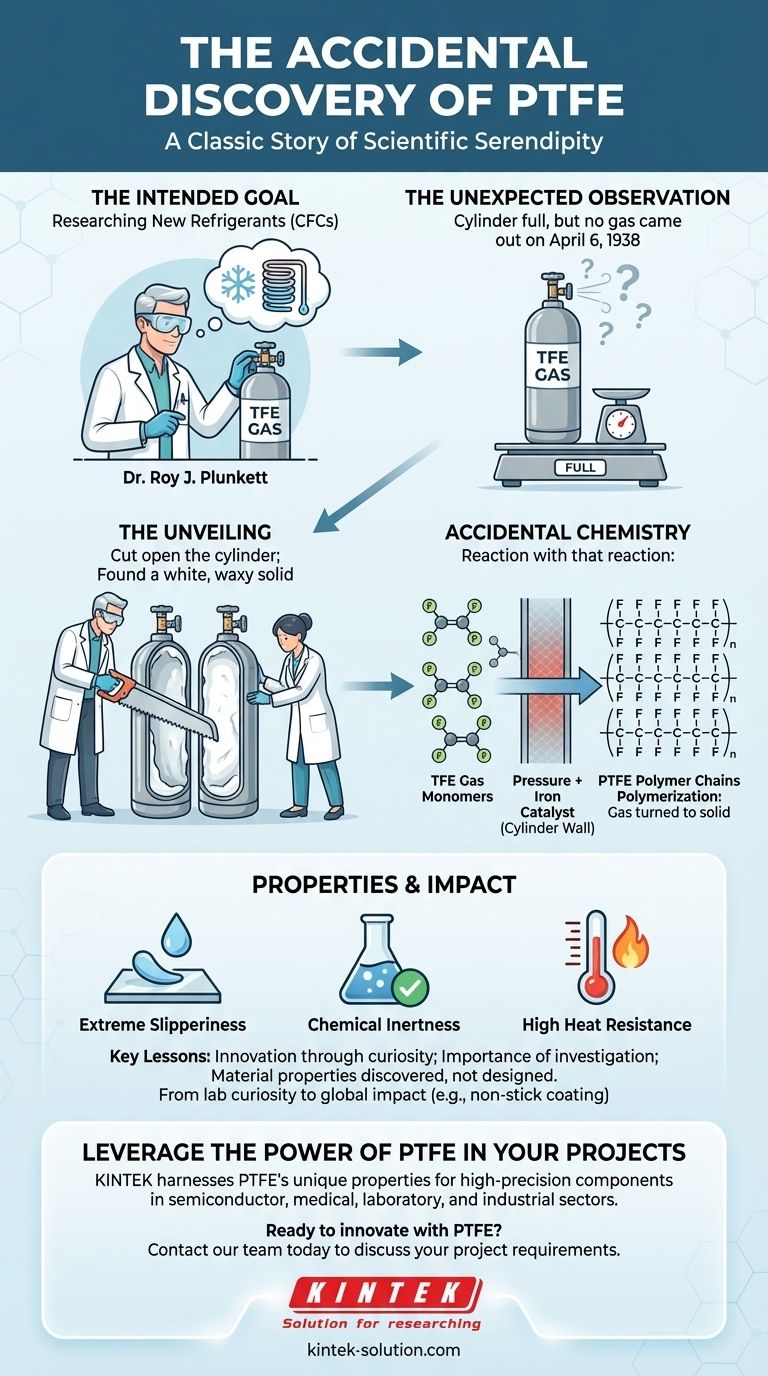The discovery of PTFE was a complete accident. Polytetrafluoroethylene (PTFE), the polymer widely known by its DuPont brand name Teflon, was discovered on April 6, 1938, by Dr. Roy J. Plunkett. A chemist working for DuPont in New Jersey, Plunkett was not trying to invent a revolutionary low-friction material but was researching new, non-toxic refrigerants when he stumbled upon the remarkable substance.
The story of PTFE is a classic example of scientific serendipity. A failed experiment with a refrigerant gas led to the creation of a material with unique properties—extreme slipperiness, chemical inertness, and high heat resistance—that would go on to have a global impact.

The Experiment That "Failed"
To understand the discovery, it is essential to look at the original goal of the experiment and the specific problem that led to the breakthrough.
The Intended Goal
Dr. Plunkett was attempting to create a new chlorofluorocarbon (CFC) refrigerant. His work involved using tetrafluoroethylene (TFE) gas, which he stored in small, pressurized metal cylinders.
The Unexpected Observation
On the morning of April 6, 1938, Plunkett selected one of his TFE cylinders for an experiment. He knew by its weight that it was still nearly full of gas, but when he opened the valve, nothing came out. The gas had seemingly vanished.
The Unveiling
Rather than discarding the apparently faulty cylinder, Plunkett's curiosity took over. He and his assistant sawed the heavy metal container in half. Inside, they found not a gas, but a strange, waxy, white solid that had coated the interior.
Understanding the Accidental Chemistry
The substance inside the cylinder was the result of a spontaneous chemical reaction that Plunkett had not intended or predicted.
From Gas to Solid
The TFE gas had undergone spontaneous polymerization. This means the individual TFE gas molecules (monomers) had linked together under pressure to form extremely long chains (polymers), transforming the gas into a solid.
The Role of a Catalyst
It is believed that the iron from the inside surface of the steel cylinder acted as a catalyst. Under the high pressure within the container, the iron initiated and accelerated the polymerization reaction, turning the entire supply of TFE gas into the new solid, PTFE.
Properties of the New Material
Plunkett quickly began testing the strange new powder. He noted it was exceptionally slippery and that it was inert, meaning it did not react with other chemicals like strong acids. It also proved to have a very high melting point.
The Significance of Serendipity
The discovery of PTFE highlights a crucial aspect of scientific and technical advancement: the value of investigating unexpected outcomes.
A Problem Becomes the Solution
Plunkett's initial problem—a gas cylinder that wouldn't dispense—was not a failure. It was the evidence of an entirely new event. His decision to investigate the anomaly, rather than simply assume an equipment malfunction, was the key to the discovery.
From Lab Curiosity to Global Impact
This accidental substance was initially a laboratory curiosity with no obvious application. However, its unique properties soon found use in critical applications during World War II, and it was eventually introduced to the public as the coating for "non-stick" pans, becoming a household name.
Key Lessons from the Discovery of PTFE
The story of PTFE's origin offers timeless insights into the nature of innovation and scientific progress.
- If your primary focus is on innovation: Recognize that breakthroughs often come from unexpected results and the curiosity to investigate anomalies.
- If your primary focus is on scientific process: Understand that careful observation is paramount; Plunkett could have discarded the "failed" cylinder, but his choice to investigate led to the discovery.
- If your primary focus is on the material itself: Remember that PTFE's remarkable properties were not designed but discovered, emerging spontaneously from a simple chemical reaction.
Ultimately, the story of PTFE is a powerful reminder that sometimes the most profound discoveries are found when you are looking for something else entirely.
Summary Table:
| Aspect | Detail |
|---|---|
| Discoverer | Dr. Roy J. Plunkett |
| Date of Discovery | April 6, 1938 |
| Company | DuPont |
| Discovery Context | Researching new refrigerants |
| Key Property Observed | Extreme slipperiness and chemical inertness |
Leverage the Power of PTFE in Your Projects
Dr. Roy Plunkett's accidental discovery unlocked a material with unparalleled properties: extreme chemical resistance, a high melting point, and a very low coefficient of friction. At KINTEK, we harness these properties to manufacture high-precision PTFE components—including seals, liners, and custom labware—for the semiconductor, medical, laboratory, and industrial sectors.
Whether you need a reliable prototype or a high-volume order, our expertise in custom PTFE fabrication ensures a solution that meets your exact specifications for performance and durability.
Ready to innovate with PTFE? Contact our team today to discuss your project requirements.
Visual Guide

Related Products
- Custom PTFE Parts Manufacturer for Teflon Containers and Components
- Custom PTFE Parts Manufacturer for Teflon Parts and PTFE Tweezers
- Custom PTFE Measuring Cylinders for Advanced Scientific and Industrial Applications
- PTFE Chemical Solvent Sampling Spoon
- Custom PTFE Volumetric Flasks for Advanced Scientific and Industrial Use
People Also Ask
- What are some applications of CNC machined PTFE parts? Critical Components for Medical, Electrical & Food Industries
- What is the working temperature range of PTFE? Master Extreme Heat and Cryogenic Applications
- What is the temperature range that PTFE can withstand? From -200°C to +260°C for Demanding Applications
- What is the hardness range of PTFE on the Shore D scale? Leveraging Its Softness for Superior Performance
- What are some important physical property values for PTFE? Master Its Extreme Performance for Demanding Applications



















